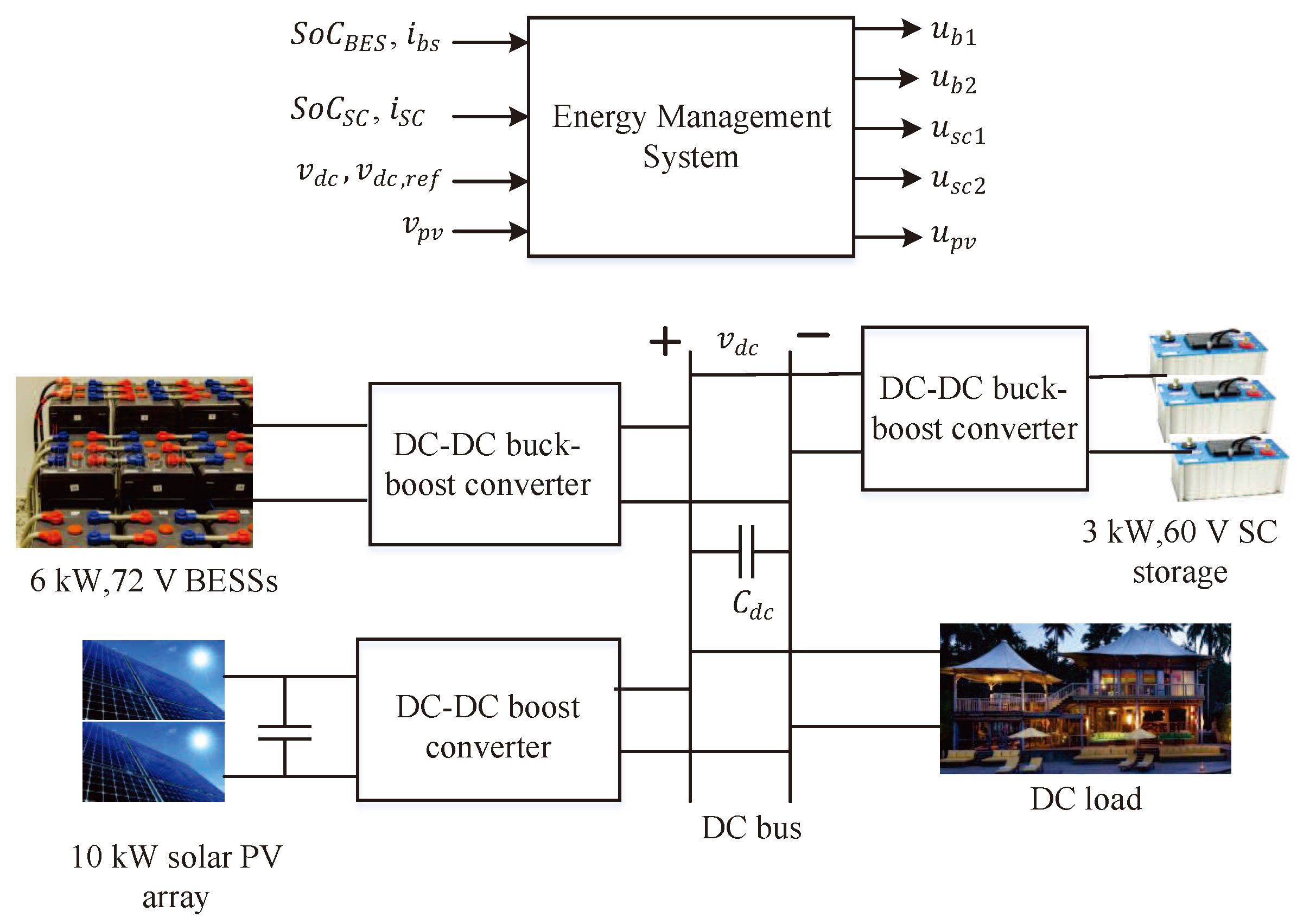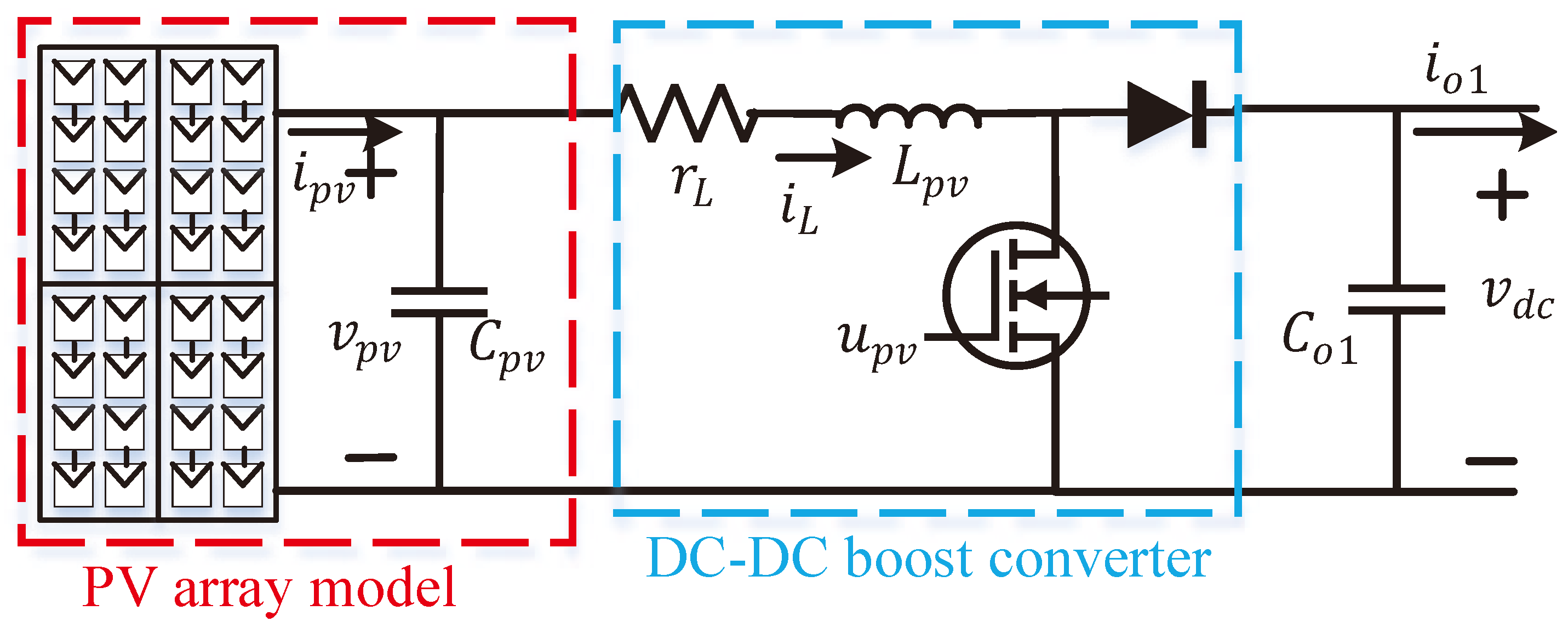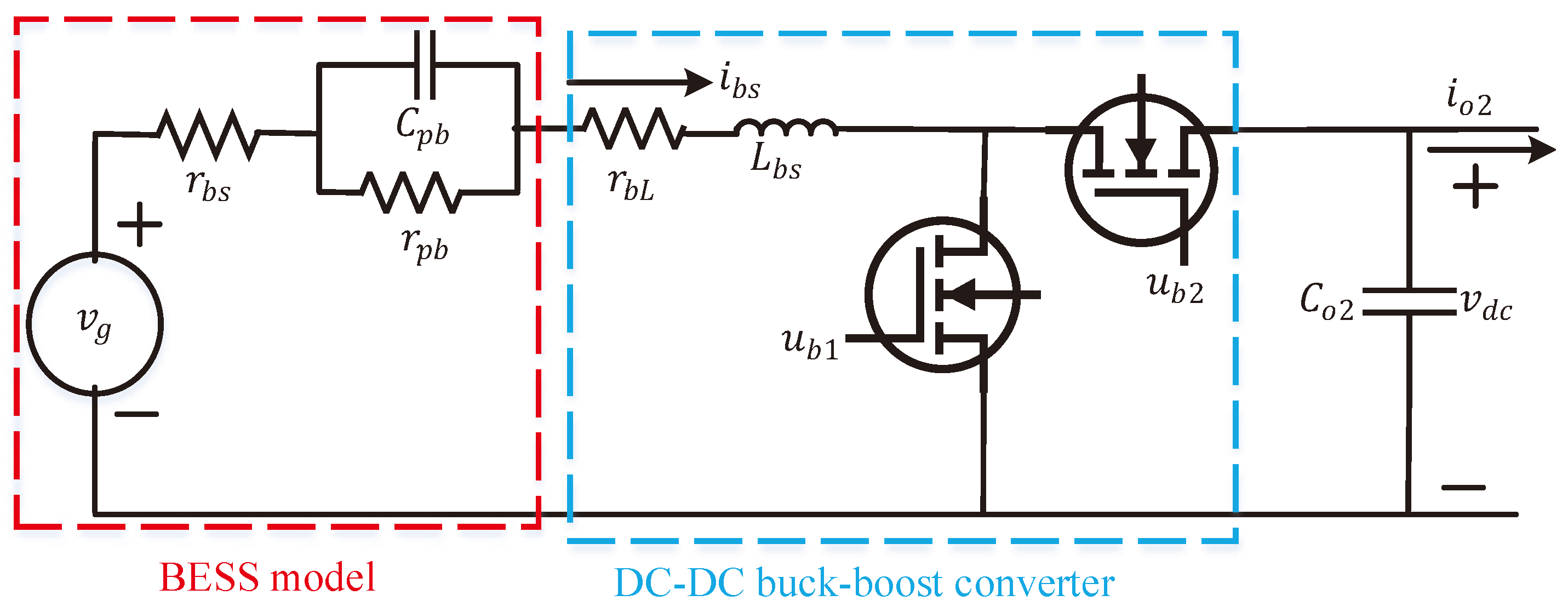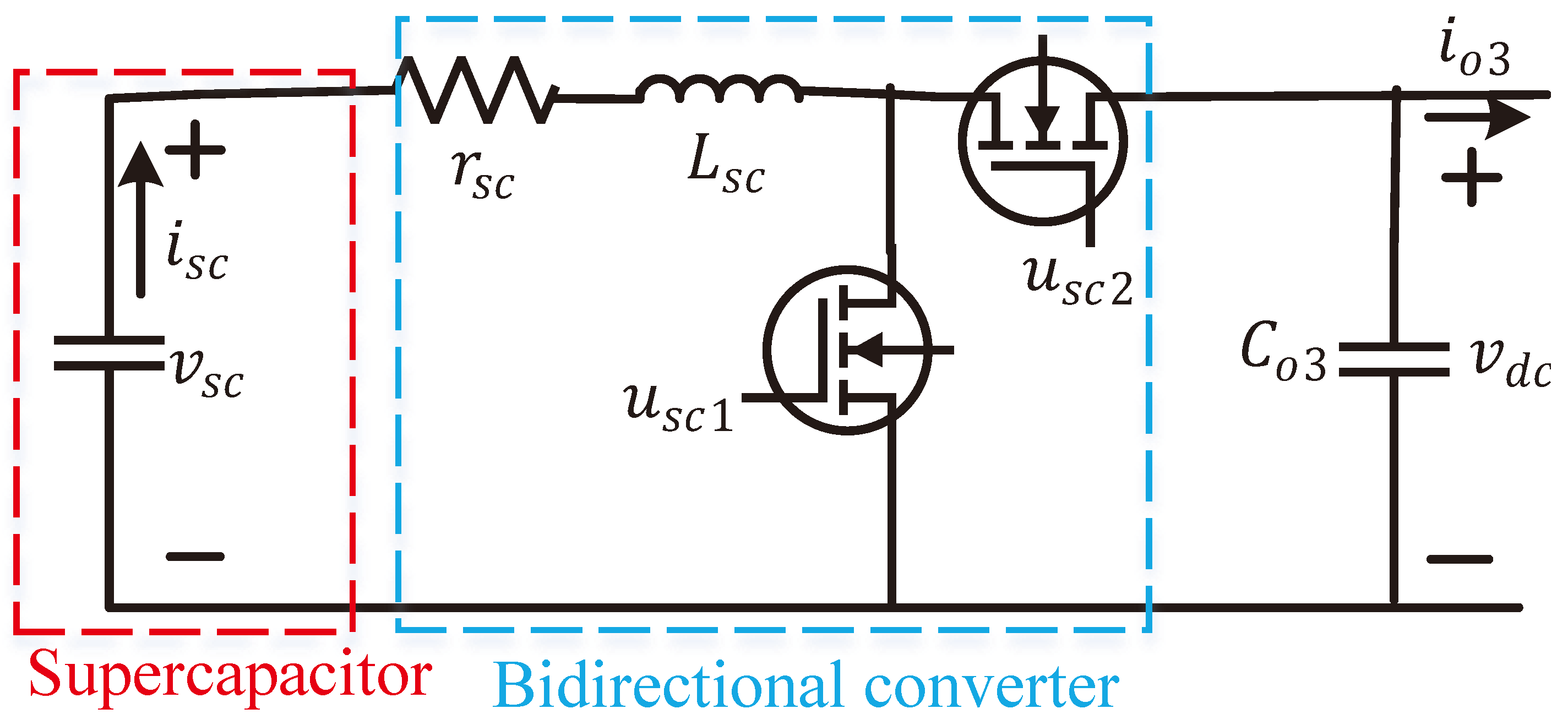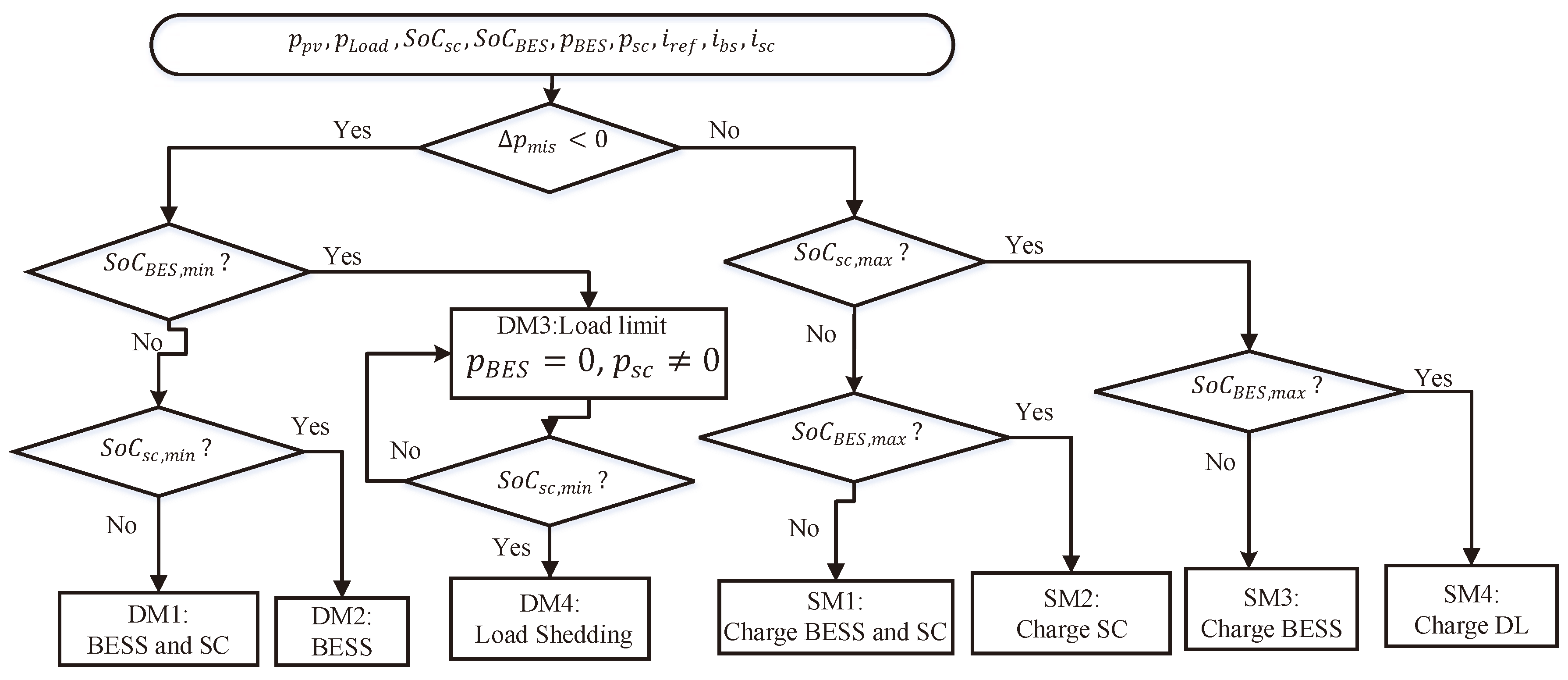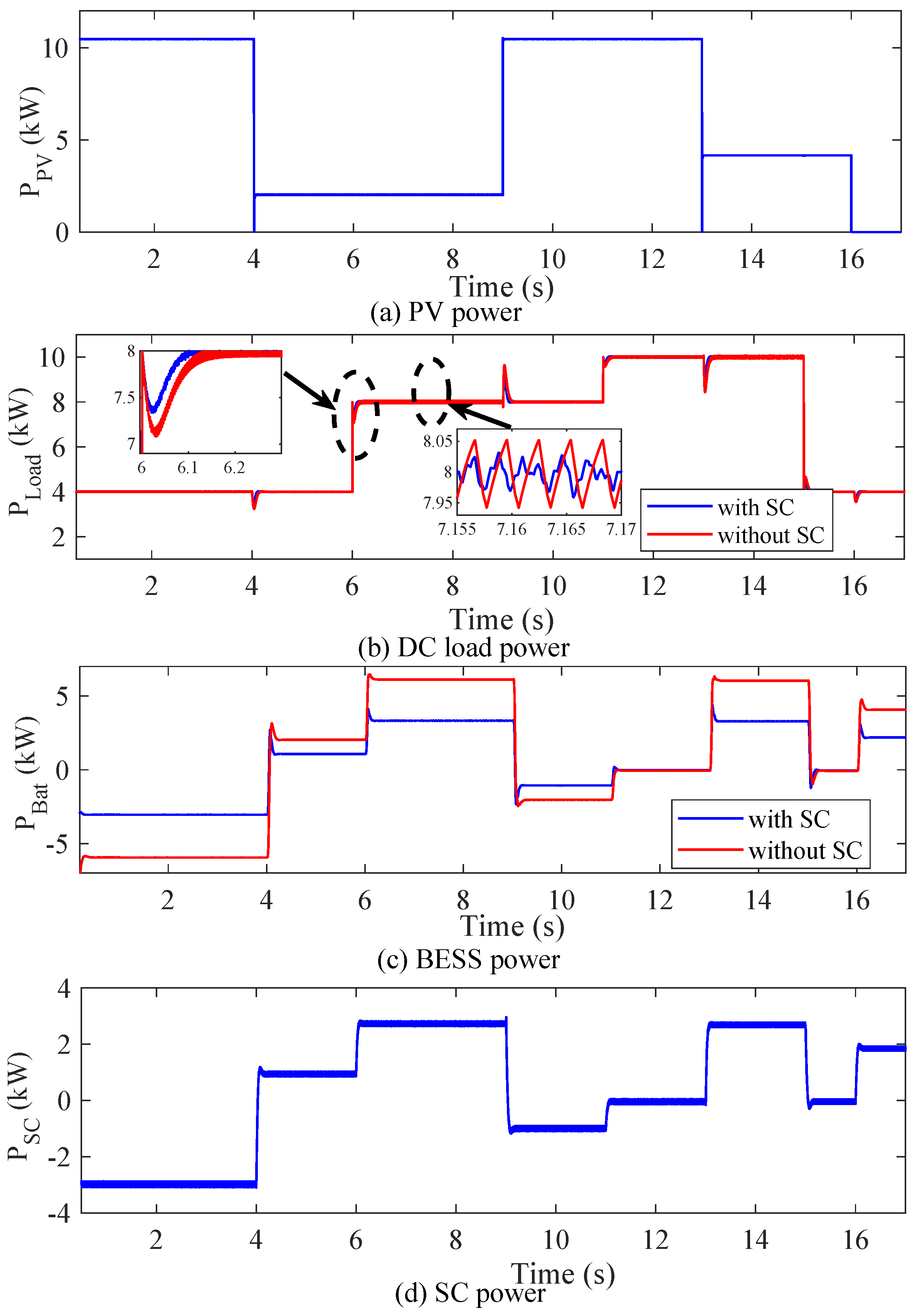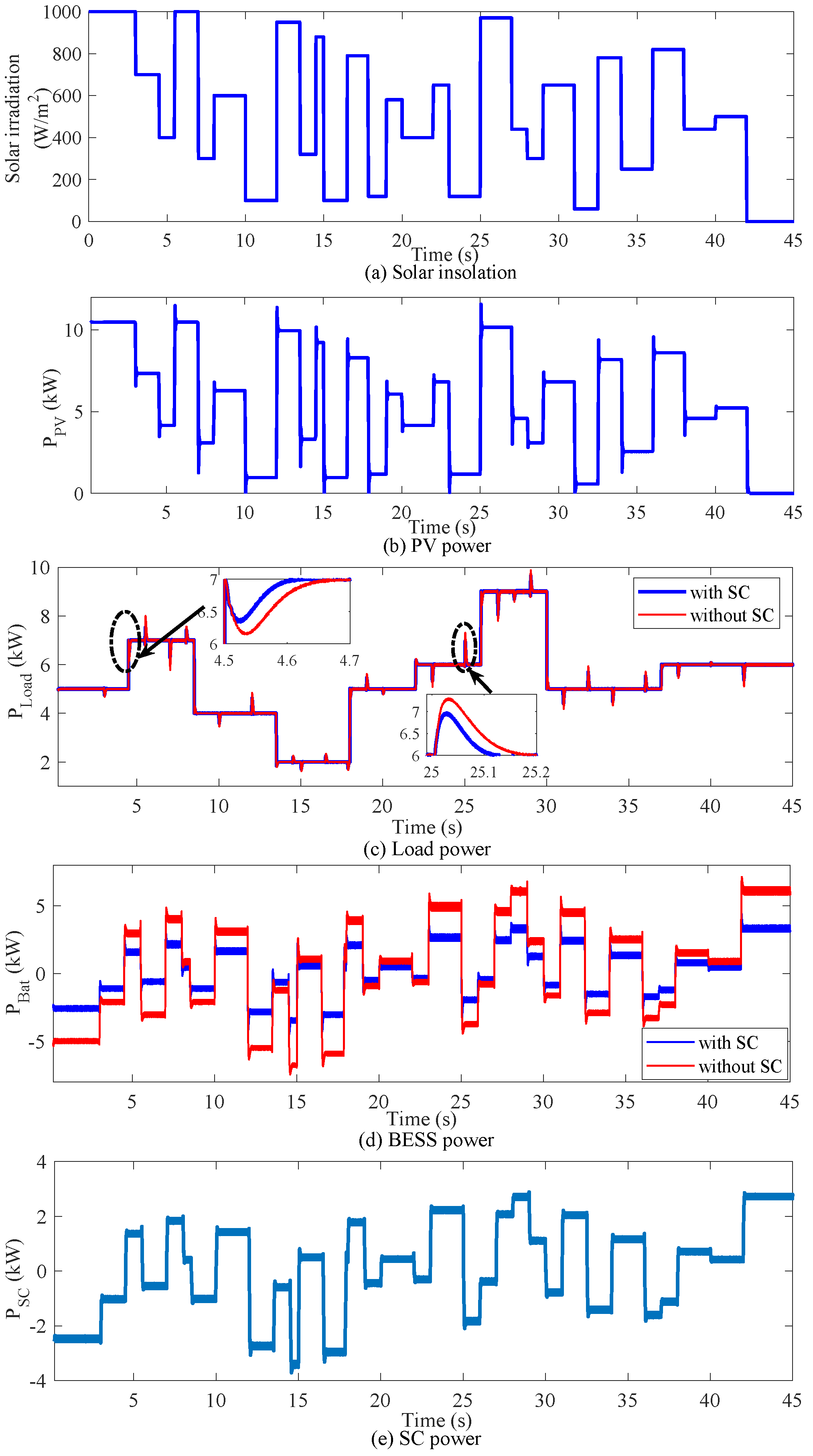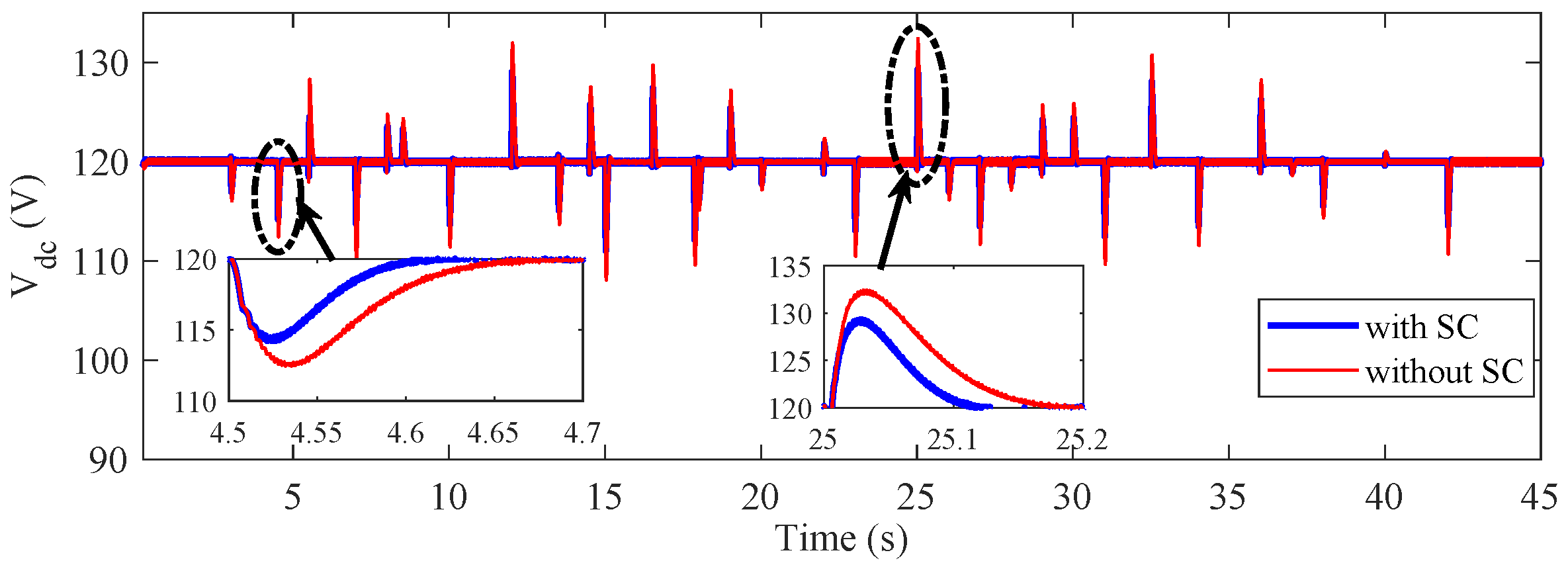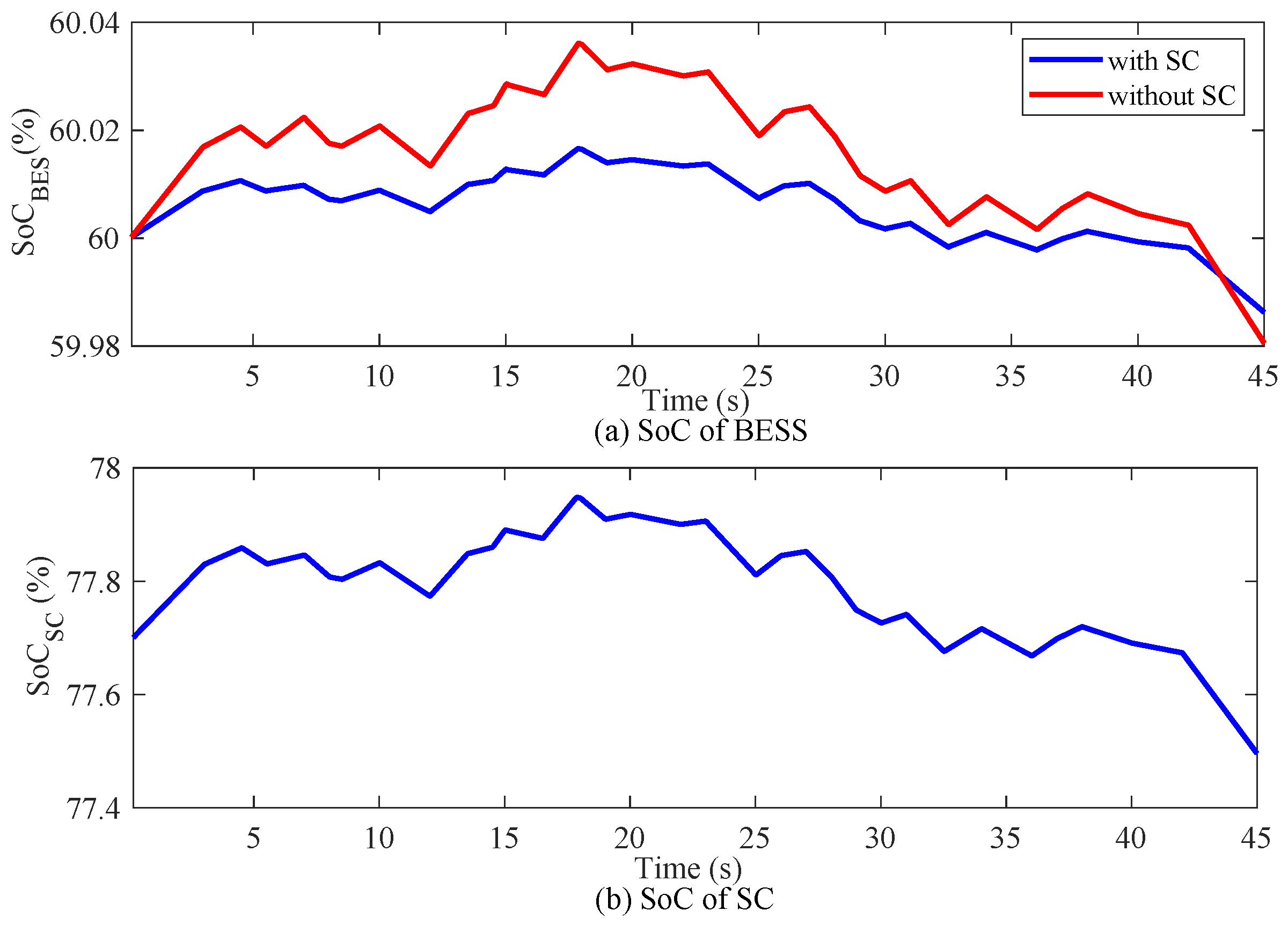1. Introduction
DC microgrids have been gain popularity over AC microgrids due to several benefits such as the utilization of power generation from solar photovoltaic (PV) systems with fewer power conversion stages, no additional requirements for frequency as well as reactive power control, etc. [
1,
2,
3,
4]. Hence, the control structure becomes simple for converters in DC microgrids and there are low power losses, which improve the overall efficiency of the system. Furthermore, some specialized applications, e.g., railway signaling systems and base transceiver systems (BTSs) in telecommunication applications, use DC power for which it is feasible to have DC microgrids with solar PV systems (as it directly generates DC power) along with energy storage systems (ESSs).
ESSs in DC microgrids are used to store the excess energy from solar PV systems and release this energy when there is no power generation from solar PV systems. In this way, ESSs maintain the proper power balance and voltage stability within DC microgrid to tackle the intermittency of solar PV systems and variations in the load demand [
5,
6,
7]. Different types of ESSs, e.g., batteries, hydrogen storage systems for fuel cells, supercapacitors (SCs), etc., are used to optimally manage the power in DC microgrids and each of these ESSs has its own distinct features [
8,
9,
10]. Battery ESSs (BESSs) have widely different applications including DC microgrids due to the maturity of the technology and their low costs as compared to other ESSs [
11,
12]. However, BESSs exhibit low power density for which the dynamic response is much slower, and, sometimes, they are unable to provide ancillary services to DC microgrids with fast changes in load demands and variations in the power generation from the solar PV units. This means that DC microgrids experience power disruptions under severe transient events. The slow dynamic response characteristics can be overcome by employing ESSs having high power density, e.g., SCs which are able to provide fast dynamic responses. However, these SCs are more expensive as compared to BESSs, and, therefore, it is important to have a trade-off between the performance and cost. This trade-off can be obtained by combing both BESSs and SCs, i.e., by forming a dual energy storage system (DESS). The DESS in DC microgrids with a proper energy management system (EMS)-based control strategy is essential to appropriately coordinate the charging and discharging of both BESSs and SCs in order to maintain the power balance as well as the voltage stability.
Different components in DC microgrids are generally controlled by using centralized control schemes to ensure the appropriate power sharing for maintaining power balance and voltage stability [
13,
14,
15,
16]. These centralized controllers centrally control ESSs for storing and releasing desired energy without having a proper EMS; thus, these controllers cannot appropriately coordinate the power sharing. Furthermore, there is an issue of the common point failure in these centralized control structures. Distributed controllers are employed in [
17,
18,
19,
20,
21] for DC microgrids which overcome some limitations (e.g., the common point failure) of the centralized controllers. These distributed controllers perfectly maintain the power balance and stability of the common DC-bus voltage with slight variations in the output power generation and load demands as these are designed based on the static models of different components in DC microgrids. These static models do not capture the dynamic characteristics of solar PV systems and ESSs that are experienced during the practical operation of DC microgrids. It is worth noting that the dynamic of the common DC-bus voltage plays a key role to ensure the power balance within the DC microgrid. This dynamic is indirectly related with the states of different components (e.g., solar PV systems and ESSs) in microgrids. Hence, the control actions for converters with these components need to be regulated in such a way that the desired voltage is obtained at the common DC-bus. This can only be achieved if ESSs are appropriately charged or discharged. An improved distributed control scheme for DC microgrids with multiple ESS is presented in [
22] to enhance the common DC-bus voltage regulation and keep the state-of-charge (SoC) within the safe operating region. A modified structure of DC microgrids grids is considered in [
23,
24,
25] where the detailed dynamical models of solar PV systems and BESSs are used without any SC. However, all these controllers are designed based on the simplified models of different components in DC microgrids without having an EMS, even though it is a key component effectively making the power sharing decisions. Furthermore, all these works have used only BESSs for storing or releasing energy in order to maintain the power balance and voltage stability.
BESSs cannot instantaneously supply power under abrupt changes in load demands and the output power of solar PV systems. Furthermore, the continuous charging and discharging of BESSs regulate the SoC over a wide range which significantly reduce the lifetime and efficiency of the battery [
26]. This problem of charging or discharging can be resolved through the DESS, which seems for attractive for DC microgrids due to its fast dynamic responses and cost-effectiveness [
27,
28,
29,
30,
31,
32]. Although these studies have shown the improvement in dynamic performance with hybrid ESSs (HESSs), the dynamic characteristics of SCs in conjunction with the BESS (which provide cost-effective solutions) have not been investigated. Furthermore, these applications of HESSs do not consider EMS-based control strategies for the optimum utilization of ESSs in DC microgrids.
This paper focuses on designing an EMS-based control strategy for DC microgrids with DESSs. Here, BESSs and SCs are combined together to form DESSs. A microgrid structure with a solar PV unit, DESS, and DC load is considered to employ the proposed EMS-based control scheme. The detailed dynamical models of each component are developed to demonstrate the importance of the dynamic of the common DC-bus voltage and its relationship with other properties of the system. Furthermore, the relationship between the dynamic of the common DC-bus voltage and power balance is revealed in this work and it demonstrates the application of a PI controller for different components to ensure the power balance. The reference values for regulating the power for different components (especially, for the solar PV unit and DESS) are determined from the EMS in order to regulate the control actions. The performance of the proposed EMS-based control scheme was evaluated under different operating conditions of the DC microgrid in order to maintain the voltage stability and power balance along with enhancing the lifetime of the BESS. Simulation results clearly demonstrate the advantages of the DESS over a single storage system under different operating conditions of the DC microgrid.
3. Proposed EMS-Based Control Strategy
The proposed EMS-based control strategy is used to maintain the power balance while ensuring the voltage stability of DC microgrids by keeping the DC-bus voltage within the limit of its desired value.
Figure 5 shows the flow chart of the proposed EMS-based control strategy. The power balance within the DC microgrid indicates that the power from the PV generation matches with the load demand, i.e., there is no mismatch between the generation and demand. Since the DC microgrid in this paper uses a solar PV system to generate power, there are huge fluctuations in the output power and the load varies continuously. Hence, there is power mismatch in the DC microgrid and the common DC-bus voltage experiences frequent fluctuations. The fluctuations in the DC-bus voltage sometime violate the voltage limit for the voltage stability. In such a condition, the DESS is used to minimize this power mismatch and maintain the voltage stability. The proposed EMS-based control scheme uses the reference currents
and
for the BESS and SC, respectively, to compensate the surplus and deficit power in a islanded DC microgrid. Now, the analytical expression for the power mismatch in a DC microgrid can be described through the following equation [
5]:
where
is the mismatch or net power of DC microgrids,
is the output DC current,
is the output power of a PV system at maximum power point,
is the output power of the BESS,
is the output power of the SC,
is the load demand,
is the equivalent capacitance of the DC- bus, and
is the rise or drop voltage of a DC-bus.
From Equation (
13), it can be seen that the common DC-bus voltage needs to be regulated to its desired value in order to ensure the power balance. A proportional integral (PI) controller can be used to regulate this common DC-bus voltage by controlling current of the DESS and the desired voltage can be obtained by minimizing the difference between the reference voltage
and measured voltage
for which Equation (
13) can be rewritten as follows:
where
and
are proportional and integral gains of the PI controller, respectively. From Equation (
14), it can be observed that the power balance can be obtained if the fluctuations in the common DC-bus voltage become zero. It is worth noting the slight variations in the common DC-bus voltage can be accepted. During the practical operations of DC microgrids, there are two operational modes as surplus power and deficit power modes. The proposed EMS-based control strategy ensures the power balance in both modes by appropriately charging or discharging the DESS while maintaining the SoC within the feasible limit. Based on these two operational modes, a comprehensive analysis of the proposed EMS-based control strategy is provided in the following subsections by considering different possible scenarios for each operating mode.
3.1. Deficit Power Mode
This mode appears when the output power of the PV unit is not sufficient to meet the total load demand (i.e.,
). In this condition, the proposed EMS-based control scheme regulates the switching control actions of the DESS in such a way that the DESS discharges to make up the deficit power of the islanded DC microgrid. Depending on the constraints related to the SoC and current of the DESS, different possible scenarios could be demonstrated to analyze the stable operation of islanded DC microgrids, as indicated in
Figure 5. All these scenarios are explained in the following.
Scenario 1 or DM1 (discharging both SC and BESS): The reference current for controlling of the charge current of the DESS is calculated from the difference between the output power of the PV unit and load demand. In this scenario, the required current is kept at the maximum discharge current limit of the BESS and SC while the SoC of both BESS and SC is kept at a higher value than the minimum SoC. Therefore, the power mismatch within the DC microgrid is managed through both battery and SC. In this scenario, the SC is discharged first to inject the power into the microgrid for quickly tackling transients due to variations in the output power of the solar PV unit and load demand so that the voltage stability is ensured. In this scenario, the SC is fully discharged before the battery.
Scenario 2 or DM2 (discharging only the battery): This scenario is an extension of DM1 in which it is considered that the SC is fully discharged while the power is still sufficiently available to compensate the power shortage of the DC microgrid. In this situation, the battery is within its SoC limit.
Scenario 3 or DM3 (fully discharging the battery, partially discharging the SC, and partially shedding load): In this mode, it is considered that the battery is fully discharged, i.e., the SoC of the battery reaches to its minimum value. Furthermore, it is considered that the SC can release some energy but it is not sufficient to match the load demand. Hence, the load shedding action is enforced.
Scenario 4 or DM4 (no power from the DESS): In this scenario, it is assumed that the DESS is fully discharged, i.e., no power from both SC and battery. However, the solar PV unit supplies power to partially meet the load demand for which it is essential to shed the load.
3.2. Surplus Power Mode
Due to uncertainties in the output power of the PV units and variations in the load demand during the operation of the DC microgrid, there are some instances where the power generation from the solar PV system is higher than the total load demand, i.e., there is an excess power and this can be categorized as surplus power mode. During this mode, the load demand is met by the PV system and the remaining power of the PV system is stored into DESS through the bidirectional converter. The excess energy within the microgrid can be controlled using a current control strategy embedded with an EMS which can be described through following four possible scenarios.
Scenario 5 or SM1 (charging both BESS and SC): In this scenario, the power mismatch within the microgrid is first calculated and the SoC for the DESS (i.e., both BESS and SC) is observed. It is also assumed that the SoCs for both BESS and SC are less their maximum limits, i.e., less than and . The DESS is charged with the surplus energy and the inclusion of the SC flattens transient behaviors with changes in DC microgrids due to its faster dynamic capability to adapt changes.
Scenario 6 or SM2 (full charging of the BESS and partial charging of the SC): In this mode, the SoC for the BESS gradually increases and fully recharged while the SC still has the ability to charge from the solar PV unit under MPPT constraints.
Scenario 7 or SM3 (both BESS and SC are fully charged): This scenario is considered by considering the situation when both BESS and SC are fully charged. It is worth noting that the excess power from the solar PV unit exactly matches with the available capacity of the DESS and load demand during this mode.
Scenario 8 or SM4 (full charging of the DESS and extra power from the PV unit): In this operating mode, it is considered that the DESS is fully charged and there is still excess power from the solar PV unit which is consumed by the dump load (DL). Based on all these scenarios, the performance of the proposed EMS-based control strategy is analyzed in the following section.
4. Simulation Results
The proposed EMS-based control scheme was employed on the DC microgrid shown in
Figure 1. In this figure, it can be seen that the load is directly connected to the common DC-bus and the rated load voltage, i.e., the common DC-bus voltage is considered as 120 V. Hence, the desired voltage level for the DC–DC converter with the solar PV unit is 120 V, which is the same as for the bidirectional converters during the discharging modes for both BESS and SC. In this study, it was assumed that the load within the DC microgrid can be varied from 0 to 10 kW and the output power from the solar PV unit was considered as 10 kW at the MPP under standard atmospheric conditions. The output voltage of the PV array was considered as 90 V and DC–DC boost converter was used to make the voltage as 120 V where this converter was controlled by the proposed EMS-based control scheme. In this study, the rated voltage and capacity of the BESS were considered as 72 V and 200 Ah, respectively. Here, a lithium-ion battery was used as the BESS. Similarly, SC having the rated voltage as 67.2 V and capacity as 10.4 Ah was used to have the DESS. This means that the proposed EMS-based scheme ensures the desired voltage as 72 V for the BESS and 67.2 V for the SC during the charging mode. The gain parameters used for different controllers are provided in
Appendix A Table A1. This newly designed energy management system was used to generate the reference signals for the controllers used in different components. Usually, the control actions require eliminating the transient characteristics within few seconds (definitely depending on the requirement). This energy management system can be integrated with the existing SCADA system and it would not require any special hardware or data acquisition system.
The effectiveness of utilizing the DESS in conjunction with the proposed EMS-based control scheme was evaluated in terms of maintaining the stability of the common DC-bus voltage and power balance under any operating condition (i.e., in both transient and steady-state conditions) of the microgrid. The results obtained using the proposed EMS-based control scheme for the DC microgrid with the DESS were compared with the same having only the BESS, i.e., without the SC. Different scenarios were considered during the simulation and the simulation was carried out using the SIMPOWER Tool Box in MATLAB/Simulink platform. It is worth mentioning that the time step for the simulation was considered as 5 s.
At the beginning of the simulation, the solar PV unit operated at the MPP under standard atmospheric conditions. It is worth noting that the standard atmospheric conditions were considered as a situation when the cell temperature is 25 C and the solar irradiation is 1000 W/m. In this condition, the solar PV unit generates 10 kW and the load demand is considered as 4 kW. The initial values of the SoC for the BESS and SC were considered as 60% and 77.7%, respectively. This means that both BESS and SC were charged from the previous operational cycle.
During the first interval of the operation, i.e., 0 ≤ t < 4 s, the power generated from the solar PV unit (10 kW) is higher than the load demand (4 kW). Since the values of the SoC for both BESS and SC are lower than their maximum limits, the excess power (i.e., 6 kW) available within the microgrid is stored into the DESS. At this instant, the proposed EMS-based control strategy regulates the bidirectional DC–DC converters of the BESS and SC to ensure the appropriate charging for maintaining the power balance within the DC microgrid. At the same time, it ensures the fluctuations in the common DC-bus voltage. At this instant, the power balance within the DC microgrid can be clearly seen from power responses of different components, as shown in
Figure 6, and an insight about the voltage stability of the DC microgrid can be found from the common DC-bus voltage, as shown in
Figure 7. The charging of the DESS can be evidenced from the increases in the SoCs for both BESS and SC, as depicted in
Figure 8. This operational scenario actually represent SM1.
During the second interval, i.e., 4 ≤ t < 9 s, it is considered that the output power of the PV unit suddenly drops from 10 to 2 kW due to the changes in the solar irradiation while the total load demand is still 4 kW until t = 6 s, which is increased to 8 kW at t = 6 s, and the operation of the DC microgrid continues until t = 9 s. Hence, the load demand is higher than the generation from the solar PV unit throughout this interval. Here, the proposed EMS-based control scheme allows releasing the energy equivalent to 2 kW from the DESS through discharging during the interval from t = 4 s to t = 6 s along with additional 4 kW from t = 6 s to t = 9 s. During this interval, both BESS and SC equally discharge to ensure the power balance, which can be evidenced from the power responses, as provided in
Figure 6. The control actions for both BESS and SC are also regulated to achieve the desired load voltage or common DC-bus voltage, i.e., 120 V. The changes in the output power of the solar PV unit at t = 4 s and the load demand at t = 6 s affect the common DC-bus voltage response, as shown in
Figure 7, in it can be seen that there are fewer disturbances with the DESS as compared to the response with only the BESS. Since the DESS discharges during this operating scenario, the SoCs for both BESS and SC will decrease, which can also be seen in
Figure 8. This operating interval represents the operating mode DM1.
At t = 9 s, the output power of the solar PV unit suddenly increases from the 2 to 10 kW and continues this power generation until t = 13 s while the load demand is kept as 8 kW until t = 11 s. During this condition (i.e., t = 9 s to t = 11 s), the DC microgrid operates with Scenario 5, i.e., SM1 where both BESS and SC are equally charged to store energy equivalent to 2 kW. These can easily be seen from all responses in
Figure 6a–d. At t = 11 s, the load demand suddenly changes from 8 to 10 kW, which is kept until t = 15 s. Since the output power of the PV unit is 10 kW until t = 13 s., there is no power mismatch from t = 11 s to t = 13 s and the DESS is not charged, as shown in
Figure 6c,d. This means that the EMS-based control scheme does not regulate the bidirectional DC–DC converters for both BESS and SC from t = 11 s to t = 13 s. Hence, the SoCs for both BESS and SC are maintained as constant from t = 11 s to t = 13 s, as shown in
Figure 8 while the common DC-bus voltage is slightly disturbed, as shown in
Figure 7, due to all these changes. However, the proposed scheme maintains the post-disturbance voltage at 120 V. The power generation from the solar PV again drops to 4 kW at t = 13 s, which continues until t = 16 s. Since the load demand is 10 kW until t = 15 s, the DESS releases energy equivalent to 6 kW from t = 13 s to t = 15 s as the load demand reduces to 4 kW at t = 15 s, which continues until the end of this simulation window at t = 17 s. There is power balance in the DC microgrid from t = 15 s to t = 16 s as the generation from the solar PV unit matches with the load demand and, thus, the DESS does not charge and discharge, which is shown in
Figure 8. However, the DESS is discharged for the remaining operation (i.e., from t = 16 s) as the output power from the PV unit reduces to zero at this instant and the only way to meet the load demand is to discharge the BESS. All these situations are depicted in
Figure 6,
Figure 7 and
Figure 8.
In
Figure 6b and
Figure 7, it can be clear observed that the DESS can quickly cope with changes in the load demand and power generation from the solar PV unit while comparing with the responses for the DC microgrid having only the BESS. In
Figure 8, it can be seen that the variations in the SoC for the BESS is much lower when the SC is used. This means that the operation of a DC microgrid having a DESS helps to avoid the deep charging or discharging of the BESS and, thus, the lifetime of the BESS is improved. In
Figure 6a, it can be seen that the output power of the PV unit becomes zero at some instances (particularly, for the values closer to zero). This is mainly because of the transient issues and values being closer to zero. Furthermore,
Figure 6,
Figure 7 and
Figure 8 show that there are step changes in the solar irradiation for which it is quite hard to distinguish the response time between the BESS and DESS. However, this would not be the case during practical operating conditions as the solar irradiation randomly varies even worse than shown in
Figure 9a. The response time is affected if these variations in the solar irradiation are more frequent, as in
Figure 9c. The power profiles of different components within the DC microgrid are shown in
Figure 9b–e, in which it is clear that there exist more transients. In this condition, the common DC-bus voltage and relevant SoCs are shown in
Figure 10 and
Figure 11.
From all these simulation results, it can be seen that the DESS with the proposed EMS-based control scheme enhances the operational reliability in terms of maintaining both voltage stability and power balances under different operating scenarios.
